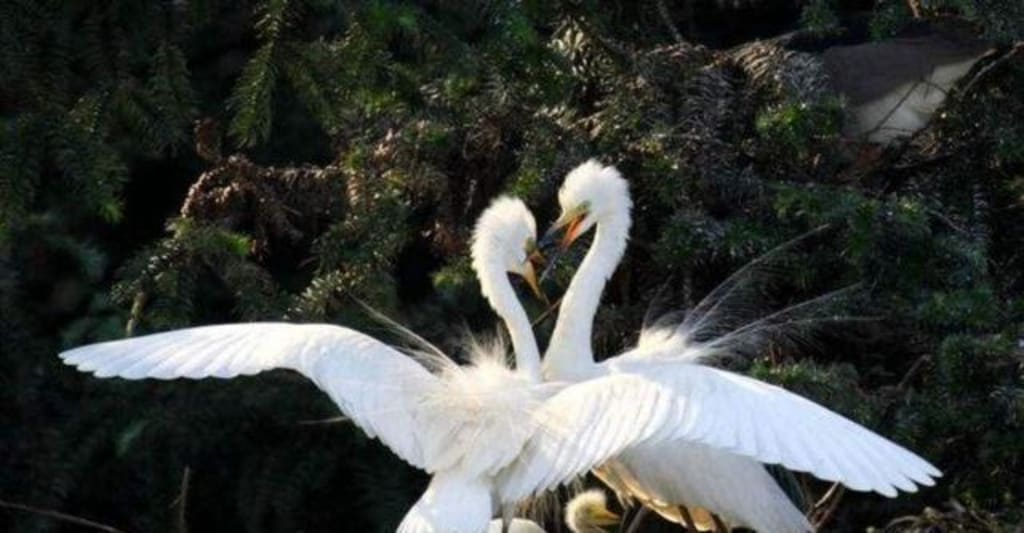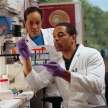Males and females mate to produce offspring
Why can't the same sex?

The wonders of nature, we may not imagine! However, behind every wonder, there is its reason.
For example, why most animals reproduce sexually, and both females and males are required to reproduce. What's more, when the number of males or females is not enough, the number of transsexuals must be filled. Let's explore why creatures evolved sex. Before understanding this, what we need to explore is:
What are the advantages of sexual reproduction? What are the disadvantages of sexual reproduction? Why can't the same sex have offspring? What "bells and whistles" have creatures evolved to reproduce?
Why do males and females mate to produce offspring? Why can't s have offspring? ame-sex
What are the advantages of sexual reproduction?
There are two ways of reproduction in nature, sexual reproduction, and asexual reproduction. Generally speaking, the organisms that reproduce asexually are mostly plants and some lower animals, such as jellyfish. So why did sexual reproduction become the mainstream of biological reproduction? Because sexual reproduction increases the survivability of organisms.
biodiversity
Sexual reproduction is the arrangement and combination of genes between two different individuals, so there will be several types of genes in the offspring. Over time, the genetic diversity of the offspring will be very rich. This is beneficial for the population to face the great changes in the environment.
For example, the offspring of a fat creature and a thin creature will have fat offspring, thin offspring, neither fat nor thin offspring, slightly fat offspring, and thin offspring. At this time, the environment undergoes drastic changes, the temperature drops, and organisms need a thick layer of fat to survive. At this time, fat, slightly fat or not fat or thin offspring have a chance to survive.
If such creatures reproduce asexually, then the fat ones become fat, and the thin ones become thin. When the environment becomes cold, the thin ones are directly cool, and only the fat ones are left, and the offspring will only be all fat ones. If the environment becomes hot again in the future, the fat people will not be able to adapt to the environment, and there will be no thin genes in the population, so they will go extinct directly.
On the contrary, in sexual reproduction, even if the environment becomes cold, thin individuals cannot survive, but thin genes still exist, and when the environment becomes warmer in the future, thin genes will appear under natural selection. In other words, sexual reproduction brings diversity, and diversity makes species more adaptive.
Increased probability of genetic variation
The genes of living things are mutating all the time. Don’t think that the mutation is harmful. T is a prerequisite for the evolution of a species. If there is no mutation, there will be no evolution. As for whether it has advantages or disadvantages, the natural environment has the final say. he mutation
If a biological population has always had a considerable mutation rate, then I probability of giving birth to new species will be greater. Sexual reproduction is a superposition of mutation rates. One generation is stronger than one generation. Variation cannot be beneficial or harmful. , but no variation is a must. It is better to give birth to new species than to eat the old ones, and it is conducive to occupying more ecological niches. Even if a species becomes extinct, as long as there are sister species, this is also a kind of genetic continuation to a certain extent. ts
For example, Dinosaurs have evolved thousands of species during their 160 million years of domination, occupying all the ecological niches they can occupy. The advantage of this is that even if the fifth mass extinction is encountered, dinosaurs can still have an ethnic group, that is, birds.
The pterosaurs, ichthyosaurs, and fin dragons, which are almost the same age as the dinosaurs, failed to survive the mass extinction because their ecological niches were limited to a certain area.
However, there is no perfect strategy in this world, and sexual reproduction is not invincible, even if it is the mainstream reproduction method of living things.
What are the disadvantages of sexual reproduction?
Although sexual reproduction allows organisms to prosper, at the same time, it may also become a shackle that imprisons organisms. In very extreme circumstances, sexual reproduction is not so versatile.
If there is only one individual left in the entire population, extinction is a foregone conclusion for sexually reproducing creatures. S reproducing animals must maintain population numbers or simply go extinct. Creatures that reproduce asexually do not have this concern. Even if there is only one individual left in the end, it can save the entire group. exually
Secondly, sexual reproduction must also avoid inbreeding, otherwise, it will be detrimental to the population, which leads to the fact that they need enough living space. If environmental changes lead to a smaller living space, then they will also come to an end.
Finally, the traits of the offspring of sexual reproduction are not stable and belong to the open blind box. If it is an SSR, then it is very likely that the entire population will take off directly; but if a time bomb is opened, it will always be lurking in the gene pool of the population. , and as the reproduction gradually spreads, there is no guarantee that it will explode one day.
However, in terms of the current living creatures on earth, the advantages of sexual reproduction outweigh the disadvantages, and it will also be the way of reproduction for most living things.
As mentioned earlier, sexual reproduction is an arrangement and combination of genes. Why can't this arrangement and combination occur between the same sex?
Why can't the same sex have offspring?
Scientists have tried experiments on parthenogenesis and parthenogenesis, and the result is that the offspring of the parthenogenetic group are large m, while the offspring of the parthenogenetic group are very small "malnutrition". ". Why does this result occur? eatballs
This does not have to mention a problem - the size of the creature. Have you ever wondered why the size of living things is limited, not infinite? Especially vertebrates, which do not allow individuals to grow indefinitely. This is controlled by bisexual reproduction. The gene of the male controls the offspring to grow up indefinitely, but the gene of the female will inhibit the growth. The two s a delicate balance in between, making the offspring just the right size. trikes
If an animal grows infinitely, it will need more and more resources. The resources are limited, and the bigger the animal grows, the more competition between species will be aggravated; and if the animal grows and becomes smaller, it will be replaced by others in the same niche. Species steal resources. Therefore, the size of each animal is the most suitable for the current environment. Even if the same sex can reproduce, the offspring will not be able to adapt to the environment.
This way of controlling the size of the offspring between males and females is called the game of males and females. There is no such game between solitary males and females, and it is difficult for offspring to survive. Even if they can survive, they will not be able to compete with male and female offspring.
Therefore, the mode of heterosexual reproduction is the most suitable for current organisms, and it is also the result of hundreds of millions of years of evolution. Scientists have not yet imagined which way can change the current male and female reproduction, maybe the sixth mass extinction.
T maintain the sex ratio of their populations, the animals play all kinds of tricks. o
What "bells and whistles" do animals play t reproduce? o
Animals multiply, only you can't think of it, without them you can't do it! The strangest thing is transgender!
Two of the most famous animals in the transgender world, the clown fish and the eel, are essentially hermaphrodites but cannot reproduce asexually.
The clownfish is male to female. Only one female is needed in a population. When the female dies, the strongest male will fill this position and become the next "queen", and then its gender will also change at this moment. Among the remaining clownfish, the largest non-sex individual will change to male at this time. Most of the others continue to remain genderless.
The eel and the clownfish are reversed, they are female to male. Eels are hermaphrodites, but they are all girls when they are young. Only after the first birth will they develop testis. At this time, it still has options, some can choose to be female all the time, and some will choose to be male. If you choose to be a male, your body size will start to grow. Therefore, the rough eels sold on the market are usually male.
Of course, transgender animals are not only clownfish and eels, among fish, b s to be a "trend". However, there is also a fish, they do not change, but the father to give c, that is the seahorse. ut transgender alsoiasoivesut bu alsoeemlso invested
Only male seahorses have breeding pouches, females do not. Therefore, the female hippocampus puts the eggs into the male hippocampus's pouch, which is then inseminated by the hippocampus father, followed by hatching, and finally, the baby hippocampus is born directly.
About the Creator
nally norris
Science needs fantasy, invention is expensive






Comments
There are no comments for this story
Be the first to respond and start the conversation.